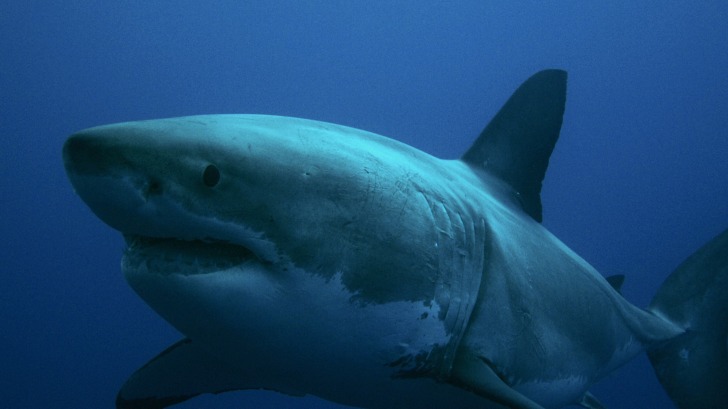Daytona Beach is located on the Atlantic Coast of Florida.
The beach in Daytona Beach is known as the most famous beach in the world.
The beach offers many activities and shops that run along the length of the beach.
The ocean on the Atlantic Coast, and more specifically, Daytona Beach, is home to a wide range of sea life including dolphins, mammals, sea turtles, and a wide range of different fish.

Contents
So… Are There Sharks in Daytona Beach
Yes. There are sharks in Daytona Beach.
In fact, there are approximately 45 different species of shark that call this part of the Atlantic their home.
Daytona Beach is located in Volusia County.
This county is known worldwide as the shark bite capital of the world.
The reason for this is that there are more shark bites in this area than in any other beach or country in the world.
So much so, that your chances of becoming a victim of a shark bite in Volusia County are ten times higher than anywhere else in the world.
Daytona beach has 23 miles of beautiful coastline.
There are 48 registered shark species in the North Atlantic and 45 of those species of shark swim in the coastal region of Daytona Beach.
While these facts may seem very scary to many people, when they are put into perspective, they paint a very different picture.
For example, Daytona Beach draws in hundreds of thousands of tourists and visitors each year.
If you consider the number of shark attacks versus the number of people that swim in the Atlantic Ocean, it seems that shark bites are not such a big threat.
In fact, you are far more likely to be hit by lightning than to be attacked by a shark in the Atlantic.
One of the most common species of sharks you’ll find in Daytona Beach is the lemon shark.
These sharks are migratory and travel to mate.
Another shark species frequently seen in Daytona Beach is the black-tip shark. Of the more dangerous species of shark you might find in the area are the bull shark and the tiger shark.
These sharks are known for their aggressive behaviors and are two of the three most dangerous sharks known for shark attacks on humans.
The biggest and least harmful sharks in Daytona Beach are the whale sharks.
While there have been several attacks in the area, only one has been fatal.
There are over 45 species of shark on Daytona beach.
In this list, we will look at only the main types of shark species that have been seen in the area:
- The lemon shark. These sharks grow to a length of about 12 feet. They are not considered to be aggressive, but they may be dangerous to humans when they are provoked.
- The blacktop shark is another species of shark that is commonly spotted in the area. These sharks grow to a length of about seven feet. They are not aggressive but may attack humans when provoked.
- The tiger shark is one of the most dangerous sharks in the ocean. They only grow to about seven feet but they are well-known to humans. They are aggressive and very dangerous.
- The Great Hammerhead shark is another apex predator known to be dangerous to humans and can be very aggressive. These sharks also grow to approximately 7 feet in length.
- The bull shark. These sharks are part of the trio of the most dangerous predators in the ocean. They are known for the most attacks on humans after the Great White Shark. Bull sharks can grow to seven feet, and are extremely dangerous, and very aggressive.
- The nurse shark is a smaller species of shark growing to only four feet in length. They are not aggressive but they can be dangerous when provoked.
- The sandbar shark is a relatively small shark in comparison to other sharks and only grows to about 7 feet. They are not aggressive but can be dangerous.
- The whale shark. These sharks are some of the largest sharks in the ocean but they’re known to be gentle giants who pose no threat to humans.
Is it Safe to Swim in Daytona Beach?
Daytona is probably the most famous beach in the world.
It’s not difficult to understand that many people flock to the beach each year from within the state and all over the country to swim in the warm Atlantic waters.
But, there are several dangers that swimmers must remain cognizant of when swimming in Daytona Beach.
Firstly, the weather is somewhat of a concern.
The weather can change very quickly and become dangerous.
Always stay on top of what the weather for the day will be when venturing out to the beach.
Sharks in the ocean are another concern.
Many of the sharks found in the Atlantic in this area are harmless to humans and will not attack.
However, some species may pose a threat and may attack, even when unprovoked.
Then there are the deadly sharks that are known for attacks on humans, such as the tiger shark and the bull shark, which are both present in the water on the east coast.
The fact that Daytona Beach is known as the shark bite capital of the world should be enough to prevent you from swimming in the ocean.
However, many people still swim here.
Daytona Beach is known for having very strong currents. Swimmers should avoid swimming too deep in the ocean.
Swimmers should take care to swim directly in front of a lifeguard in designated swimming areas only.
It’s imperative to become familiar with the tides in Daytona Beach and the best and worst times for swimming.
Coastal drowning accounts for over $280 million dollars in direct and indirect costs each year.

Interesting Shark Facts in Daytona Beach
There are over 500 different species of sharks and only 45 of these species are found in the waters in Daytona Beach.
Some female sharks are able to reproduce independently, which means that they do not need to be fertilized by male sharks.
When female sharks reproduce by themselves, the term that is used is asexual sharks.
This means that their unfertilized eggs are able to grow into fully formed sharks.
It may seem like a win-win situation, but there are drawbacks to asexual reproduction.
These sharks have less genetic diversity, which means that they are more susceptible to diseases.
The three different shark species that are most known for deadly attacks on humans are the Great White shark, the bull shark, and the tiger shark.
The scariest fact is that the US sees more shark attacks and more fatal shark attacks than any other region or country in the world.
Although not all the attacks in the US are fatal. Many attacks are a case of mistaken identity.
Most sharks live in salt water. But the exception to this rule is sharks, like the bull shark.
They have adapted to freshwater but predominantly live in salt water.
Some freshwater sharks live in freshwater and never venture into saltwater.
Saltwater makes sharks more buoyant.
Research suggests that most sharks are less buoyant in freshwater.
Most bony fish have gas-filled swim bladders that help them stay afloat in salt water.
However, sharks have oil-filled livers that help them stay afloat.
Sharks who live in freshwater have very large livers to help them cope with the lack of salt in the water and keep them afloat and buoyant in freshwater.
The Ganges sharks have exceptionally large oil-filled livers.
Their livers have adapted to living in freshwater environments.
That is why these types of sharks are able to live and thrive in freshwater.
Sharks are very salty and almost more salty than the water they swim in.
The sharks inhale the water through their gills and expel what they do not need.
The salt in freshwater is too little and the freshwater may dilute their bodies.
This may cause their cells to rupture, which may make them bloat and cause the sharks to die.
Saltwater sharks have not adapted to freshwater.
But, some saltwater sharks have, like the bull shark.
3 Safety Tips for Swiming in Shark-infested Waters
- Don’t swim in shark-infested water. This may seem like an obvious warning, but it is often not taken seriously enough. If you do happen to go swimming in shark-infested waters, it’s best to always swim in a group. Try not to be at the edge of the group and always remain alert when you are in the water. There are some dangerous sharks in this area, such as the bull shark and the tiger shark. These sharks are known to attack humans and can be very aggressive. Also, if you do plan on swimming in the water with sharks, do not splash too much or create too much noise. Sharks have an excellent sense of hearing and smell. They can pick up prey from hundreds of yards away.
- Avoid wearing bright colors or shiny jewelry when going to swim in the ocean. Sharks also have excellent eyesight. They use their eyes to detect prey. They are drawn to two things: bright colors and shiny objects. If you wear jewelry, the shark may confuse this with the scales of a fish and attack. Or, if you wear bright-colored swimwear, the shark may easily be able to single you out and hunt you for food.
- Stay out of the water if you are actively bleeding. Another excellent ability of sharks is their keen sense of smell. If you are bleeding, you should stay out of the water. Especially if there are other swimmers such as young children or older people who might not be able to swim as fast. Blood in the water will draw the sharks to the area where you are swimming and they will start to attack.
Summary
The water temperature at Daytona beach is ideal for attracting sharks.
The area is known for shark bites and is the shark capital of the world.
However, when you put into perspective the number of visitors to the beach, you may find that shark attacks aren’t really all that common.
There are several other threats on and around the beaches in Daytona Beach that visitors and swimmers must remain cognizant of to secure their safety.
Weather, dangerous conditions in the ocean such as rip currents, and piers located close to the beach, may all pose a real threat to the safety of visitors to the area.
Provided that swimmers remain in designated swimming areas, practice reasonable caution, and remain alert when on the beach in Daytona Beach, there shouldn’t be too much to be worried about.
Daytona Beach Safety Overview
READ THE FULL REPORT: Daytona Beach Safety Review
Safety Index:
- OVERALL RISK: LOW
- TRANSPORT & TAXIS RISK: LOW
- PICKPOCKETS RISK: MEDIUM
- NATURAL DISASTERS RISK: LOW
- MUGGING RISK: MEDIUM
- TERRORISM RISK: LOW
- SCAMS RISK: LOW
- WOMEN TRAVELERS RISK: LOW
Frequently Asked Questions
Are shark attacks common on Daytona beach?
Yes.
In fact, Volusia County, which is where Daytona beach is located, is known as the shark capital of the world.
According to ISAF data, there have been 94 recorded shark attacks in the area from 2012 through 2021.
All of these attacks were unprovoked.
In addition, there have been 337 shark attacks recorded in the area since 1882.
What time of year are sharks most active on Daytona beach?
Sharks are most active on Daytona beach during the summer.
From April through October, this time period constitutes summer to fall.
During this period, many sharks can be seen coming closer to the shoreline in search of food.
This also happens to be the time of year when there are more humans on the beach and in the water.
Where can I see sharks in Daytona Beach?
Shark sightings may be common in the inlet, southwards, and New Smyrna Beachside.
These areas are known for shark bites and shark attacks.
If you want to see a shark in this area, these are the spots where you are most likely to find sharks.












As a local, I can say that while there are sharks in Daytona Beach and the surrounding Atlantic waters, they should not deter visitors from enjoying all of the other amazing activities and experiences this beach has to offer.